Bachstr. 2 (previously Hauptstr. 45)
The Stumbling Stones are located on the Hauptstraße (north side), east of the Bachstraße intersection.
The Baer and Metzger families from Rodalben
Two families left in the night from August 26 to 27 1939 the Palatine village of Rodalben to move to Suessen. They had to leave their home because the then Rodalben mayor Eugen Willenbacher made use of the beginning of the Second World War to drive out the last Jews of his village. They moved to their relations in Suessen.
Alfred Baer, born September 14 1875 in Rodalben was accompanied by his wife Hilda, known as Hermine, née Lang, born January 5 1984 in Ernsbach as well as the children Hans Kurt (known as Hans Ernst), born April 12 1917 in Pforzheim, Werner Josef, born August 13 1923 in Rodalben and little Siegfried, born October 4 1930, also in Rodalben.
Alfred Metzger, born September 14 1875 in Kirchheimbolanden, came together with his wife Eugenie, née Baer, born December 3 1881 in Rodalben and their son Rudolf (Rudi) Julius, born April 29 1922 in Rodalben.
Alfred Baer and Eugenie Metzger were brother and sister of Pauline Lang, who was born December 25 1885 in Rodalben and died November 22 1935 in Tuebingen. She had married Lazarus (known as Louis) Lang in Rodalben July 6 1920.
But there were even more family connections as Hermine (Hilda) Baer was the natural sister of Louis and Leopold Lang.
It is known that the Baer and Metzger children often had spent their vacations in Suessen. And the Lang children had been visiting in Rodalben several times. Thus it was almost logical that the two Rodalben families escaped to their relations in Suessen.
The Baer family
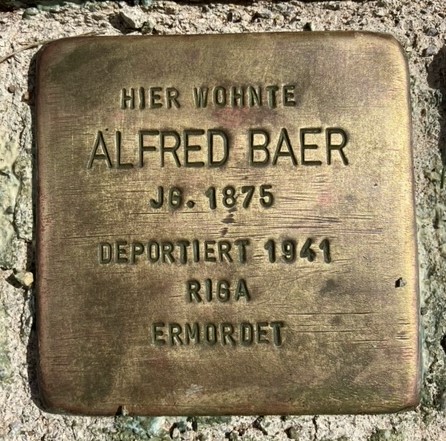
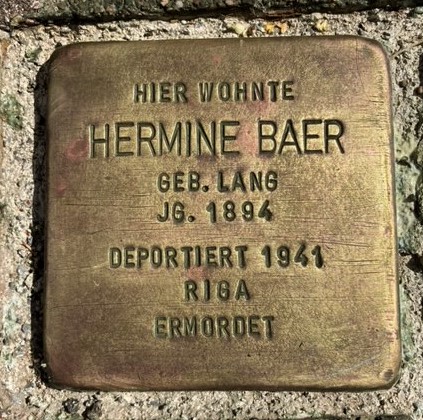
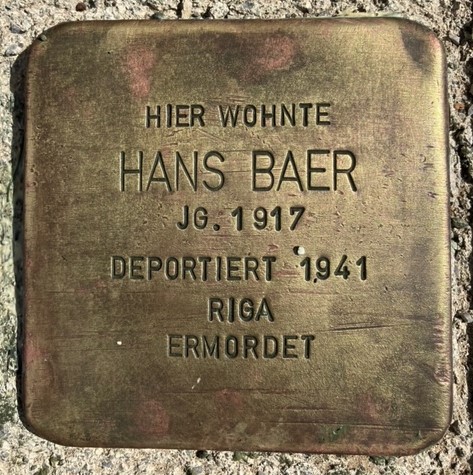
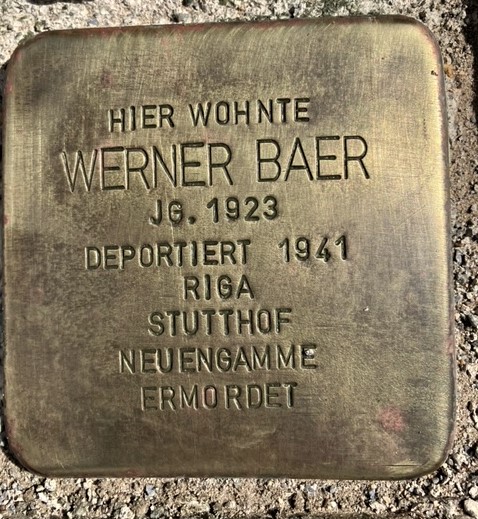
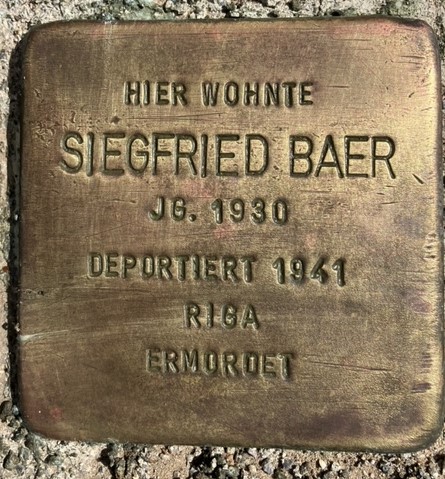
Alfred Baer was the oldest child of the Jewish tradesman Josef Baer (born February 1 1848, died May10 1922) and his wife Henriette, née Kahn (born July 1 1856, died August 13 1903). His trade was peddler which meant that he was very poor – as an elderly Rodalben citizen told me – and that he moved across the country with an oilcloth in which he stored all the goods he tried to sell – like towels, bed linen etc. In the amending order to the list of Jewish trades Rodalben the following statement is noted on November 3 1938: “In the list of Jewish Trades the following entry was deleted: Baer, Alfred, retail trader, peddler with haberdashery, scrap of cloth and manufactured goods, Baer, Alfred, Rodalben, Friedhofstrasse 7, emigration imminent.”
Fred Samuel, a holocaust survivor from Rodalben ( who among others once had spent his vacations with his friend Rudi Metzger “with Aunt Pauline” in Suessen) told me some years ago that Alfred Baer on the one hand was a very nice man, on the other hand he had been a “Schalwes” which means a simple retarded person who without the financial support by his sister Eugenie (Metzger) and Mr Samuel’s father Ludwig Samuel, who was his cousin, would not have been able to exist.
Alfred Baer was, Herr Samuel continued, had been ordered back from Vicksburg USA especially for the marriage with Hermine Lang, which took place on July 2 1920 in Ernsbach. As Alfred Baer took part in the First World War he could not for a very long time have stayed in Vicksburg with his relatives (where there was a dry goods business of his brother Lazarus and Abraham Baer who had emigrated from Rodalben). At any rate, he was not an American citizen even if he maintained that against the Suessen Mayor in December 1939.
Hermine, his wife, had lived for some time with her sisters and brothers in Suessen, even before the birth of her illegitimate son Hans. After the wedding in Ernsbach she (who was described as intelligent by Herr Samuel as well as by Kurt Lang) moved with her husband and her son (who received on the wedding day the family name of “the father” Baer) to Rodalben into Friedhofstrasse 7 (see above) where Alfred Baer owned a house.
On June 13 1921 the first common child of the couple was born in Pirmasens, Herbert Heinrich Baer, known as Hugo, who possibly emigrated to the USA at the beginning of 1936 (such is mentioned in the newsletter of the Israelite Cultural Community Pirmasens of July 21 1936/37: “the relief organization of Jews in Germany completes their action of sending Jewish schoolchildren to America which has been interrupted in the previous year. In the course of this action Gerhard Nellhaus from our community will start the voyage to the USA from Hamburg on the 23rd of the month. Before him three boys from our community, two further boys from our neighboring village Rodalben have taken this path thanks to the negotiating and support by the relief organization …” – and as in later editions Herbert Baer is not mentioned he must be one of the two boys). His two younger brothers, Werner and Siegfried Baer, did not have this chance.
After the Reich Pogrom Night Alfred Baer was taken into Schutzhaft (protective arrest) in Pirmasens on November 10 1938 but shortly afterwards sent home – probably because of his age.
Hans Baer on the other hand was sent to KZ Dachau where he stayed till January 21 1939. At least there is a short anecdote about him which was told to me by letter years ago by an elderly Rodalben citizen who deceased in the meantime:
“I know about an older son of Mrs Baer who she was said to have brought into wedlock (…). I mention the year 1939 because this older son a tailor of trade in 1939 has shortened my first long trousers . My mother had bought a suit for me at Antoinette Becker’s (…) in Schillerstrasse. And Frau Becker stealthily took the trousers to this young Jewish tailor who made a living in his very much endangered life by such alternations.”
That Hans was a tailor is owed to another sister of Alfred and Eugenie Baer namely Louise Mann who lived with her family in the house of Alfred Baer and was a mistress tailor by trade.
In April 1939 Alfred Baer had to sell his house in Friedhofstrasse forcibly and had to leave Rodalben at the end of August 1939. His family moved to Louis Lazarus Lang in Hindenburgstrasse 45 in Suessen. Alfred Baer seems not to have been forced to forced labour – according to Hugo Lang- because of his old age. Hermine Baer helped to work in the Lang household. She was said to be very quiet all the time. Hans Baer had to do forced labour – like for example Alfred and Rudi Metzger – in Eislingen in the branch of the Friedrich Bader Company. “In summer and in winter”, thus Hugo Lang, “ we had to ride our bikes there every day as well as on Saturdays”.
Alfred and Hermine Baer tried everything to at least save their two youngest children somehow. They sent Werner on January 2 1940 to Gross-Breesen a Jewish training camp for emigration north of Breslau where he was supposed to be prepared for two years for a future life in Palestine. On December 1 1940 Siegfried moved to Frankfurt/ Main where he lived in Rueckertstrasse 53 where the Israelite teachers and students’ home was. Possibly – such is my guess – they received private schooling.
As the Suessen community clerk Karl Haefele stated in his judicial examination in September 1948 that Alfred and Hermine Baer had “their two boys“ “shortly before deportation” come to Suessen, we can assume that they also were deported to Riga from Suessen via Stuttgart at the end of November 1941.
Apart from Hans all seem to have been murdered immediately in Riga.
Namely the Memorial Book – Victims of the Persecution under National Sozialist Rule in Germany 1933 – 1945″ says that Werner was in KZ Neuengamme but this could not be confirmed by the archives there. On the contrary, Hans came to Meppen-Viersen on January 16 1945, a branch of KZ Neuengamme. If what Fred Samuel told me by phone years ago is true, Hans has been murdered on one of the death marches at the end of the war.
Only Herbert Heinrich Baer, known as Hugo in Germany, in America Herbie, has survived. Fred Samuel told me that Herbert had worked for the US mail in the States and that he did know absolutely nothing about the fate of his relatives. He was said to be a mighty nice guy who had wanted to marry a young Jew called Elkan from Speyer. She then had actually come from Cairo to America, but had cancelled the wedding at the last moment. So Herbert who died on October 1995 at the age of 74 had married an American lady from Brooklyn, New York.
I mention this because Herbert’s wife – my research says she must be Shirley Baer born 1928, died January 2017 – won a restitution trial in 2002 in which the property of Alfred Baer was discussed. There it was said among others: “The suitor stated that the family had told her husband the property of Swiss bank accounts which his parents as well as cousins had set up hoping to escape the persecution through the Nazis and hoping to be able to settle in the USA. The suitor stated further that her husband had received about 7,000 US Dollars in compensation after the Second World War by the German State.
She received 47,400 Swiss Francs – so much was the value of the lives of Alfred, Hermine, Hans, Werner and Siegfried Baer.
The Metzger Family
Alfred Metzger was the third child of butcher master Abraham Metzger, born August 8 1844 in Gauersheim, died February 13 1935 in Kirchheimbolanden, and his wife Maria Seeh, born August 29 1849 in Hochspeyer, died in 1923 in Kirchheimbolanden.
Alfred Metzger operated first a business with manufactured goods, from 1914 till 1918 he served in the war, where he earned a cross of honor and on February 15 1919 he opened a cigar shop en gros in his home town. On March 11 1921 her married Eugenie Baer in Rodalben, the fourth of eleven children of the above mentioned couple Josef and Henriette Baer, and he took over the business of his father-in-law in Hauptstrasse 103 in Rodalben. In an advertisment in 1930 there is a list of goods that could be bought at his shop: “Cloths for men’s suits, cloths for dresses and silk cloths, cotton goods, underwear, table cloths and bed cloths, bathing suits, bathing dressing gowns, terry cloths, stores, adjusted and in one piece, gentlemen, ladies and children confection, men’s hats, folding hats and caps in amble selection, all haberdashery and woolen goods, gents’ and ladies’ umbrellas, constantly novelties in ties”.
On April 29 1922 their son Rudolf Julius, known as Rudi, was born. And on December 4 1923 their daughter Henriette Maria, known as Henny, was born. The business was running well, the children were growing, everything seemed to be in best order. Till the Nazis took power.
In the times of National Socialism
Edmund Heringer, the only Rodalben citizen who has taken interest in the fate of the Jewish inhabitants of the community wrote among others:
“The open attacks against the Jewish citizens in Rodalben, too, had begun as soon as the seizure of power by the National Socialists on January 30 1933. In every speech there were attacks on the Jews. On April 1 1933 there was boycott day also in Rodalben in which the citizens were asked not to buy with Jews. On the Jewish shops in Rodalben there were posters with the text: “Do not buy at Jews!”, as for example on the textile business Bloch (…), on the butchery Katz (…), on the hardware store Katz (…) and on the draper’s shop Baer-Metzger (sic!), the business of “Baere Eichene” known in Rodalben as such. SA patrolled on the sidewalks in front of these businesses so that nobody dared to enter. Who did so anyway was fotographed and got into trouble.” “1937: I experience how a crowd of children are chasing the son of the textile business Metzger Baer through the streets with calls like ‘Jew-Jew, stinking Jew’. The parents do not disturb the children”, was one more quotation from the feather of Herr Heringer. The son who was chased through Rodalben was Rudi Metzger.
But Eugenie Metzger (the mentioned ‚Baere Eichene‘) was a determined woman who did not put up with such things. Several times I was told by older citizens that she fought against the machinations of the Nazis. Thus Fred Samuel – mentioned several times – told me with laughter some years ago how Mrs Baer after the SA had smeared the window of her business and Walter Cronauer was ready to take photographs of people who went into and out of the shop had taken her main book, went out into the street to confront Cronauer with his debts towards her. On April 24 and 26 1933 their were two adverts in the Catholic and everything far from antisemite Rodalben paper “Graefensteinbote” which also spoke of Eugenie Metzger’s courage: On October 1935 Alfred Metzger became a member of on of the three synagogue councillors.
Pogrom Night in Rodalben
And then came the Reich Pogrom Night which was portrayed by Herr Herlinger as such: “Due to an official note it was (…) the SA Troop Rodalben who destroyed the shop windows of the butchery Baer(sic) and Bloch. It were the SA people who were especially active. One SA man had to take the First Aid by the Red Cross because he had wounded his arm heavily when destroying the shop window of the Baers. The two Red Cross helpers took the daughter Henny of Eugenie Metzger/Baer in custody and took her home with them. Thus she was safe from the NS hooligans. Henny decided quickly and went through Holland into a foreign country”. And further: “The windows were barred with nails. (…) The Jew Metzger who had defended himself was taken to the Volksgarten in Pirmasens.” Alfred and Eugenie Metzger were forced to pass an authorized statement “to the Kreiswirtschaftsberater of the NSDAP (…) in Pirmasens in order to prove the administration in trust of their property” as it was said. They had to close their shop. One day afterwards Alfred Metzger was taken to KZ Dachau of which he was dismissed on December 16 1938.
“Some Jewish families were sent to the house of the former textile business Eugenie Baer (sic!) (…). Thus one has opened a little ghetto out of which the Jewish fellows could only break out for shopping in the evening.” Again I am quoting Edmund Heringer.
Thus the house of the Metzger family was turned into Rodalben Ghetto in which altogether four parties lived one of which was not Jewish. Finally the Metzgers were kept prisoners in their own house and had to disappear from Rodalben. The frequently repeated claim by Rodalben Nazi Mayor Eugen Willenbacher in his letters to the Mayor of Suessen Fritz Saalmueller that the Mezgers and the Baers had left Rodalben of their own free will is nothing but a bare-faced lie. They also moved to Louis Lazarus Lang in Hindenburgstrasse 45.
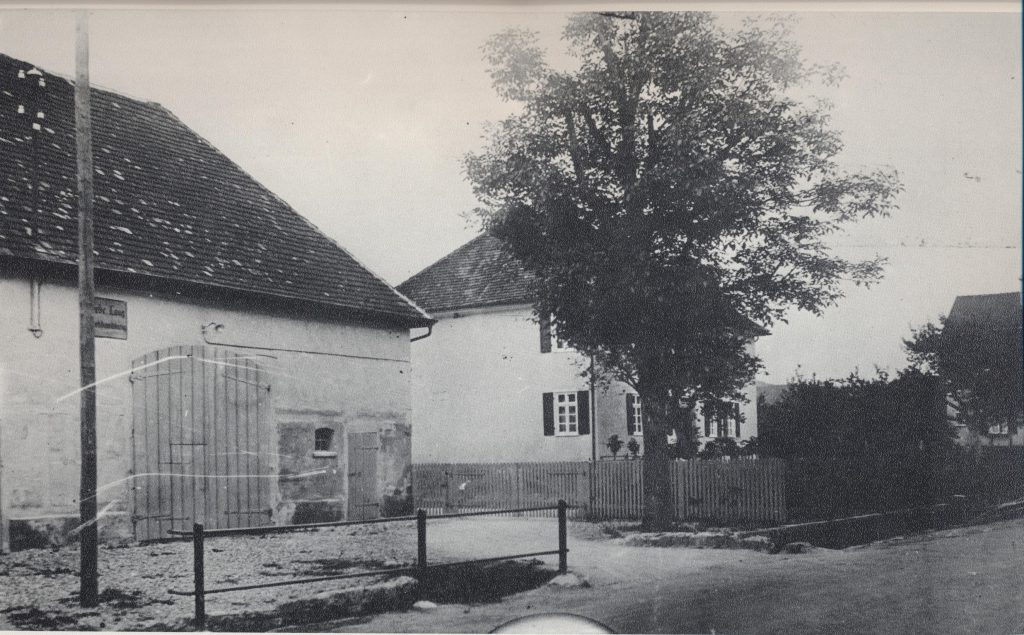
residential house with barn, around 1930 (Photo: Süßen City Archive)
The short time in Suessen
“Frau Metzger has helped in the household, cooking, washing etc. She was always sad and withdrawn, omething that we could understand, “ Hugo Lang wrote to me in 2008. She, who had once been strong and resolute, was a broken woman. Her husband Alfred and her son Rudi had to do forced labour in Eislingen – as mentioned earlier. “The company has cut all sorts of wood for the Wehrmacht, of course for bunkers, too. Only Alfred Metzger and my uncle Louis were allowed to go by train through special permit by the mayor’s office.” A further statement from a letter by Hugo Lang.
All three men were deported to Riga – like all other Suessen Jews – and murdered there.
The Escaped
Henriette Metzger arrived in 1939 in Sweden where she was a student at the International School in Västerby – financially supported by her parents as much as was possible. In January 1942 she moved to Helsingborg to be trained as a seamstress and to be kept alive through several casual jobs. In Helsingborg then Ludwig Samuel of Rodalben lived (he was the uncle of Fred Samuel’s father, who was also called Ludwig Samuel) who had been Rodalben’s Jewish teacher from 1909 tlll 1913 and his daughter Betty Bergstein, both of which knew Henriette Metzger very well. In April 1943 Henriette went to Haessleholm only to move a short time later to Moelndal where she worked as an envelope processing clerk. On June 24 1945 she married Harald Schloss (who was born in Koblenz on January 10 1917 and who died in March 1980) with whom she had two children. At the end of October the small family left Sweden to go to Israel. In 1951 Henriette Schloss as she was named in the meantime was for a short time in Rodalben where she was considering to reopen the parental business. A thought that she quickly dismissed. Later she lived in Haifa and isolated herself completely till her death some years ago as well against her cousins as against her old girl-friends in Rodalben.
In October 1956 she stated to the sheets of Yad Vashem the following point of time for the death of her relatives. For her father 15.01.1942. For her mother 23.03.1942. For her brother28.0.1942. She had certainly got the dates from her cousin Kurt Lang who had survived the KZs.
Purim at Rodalben
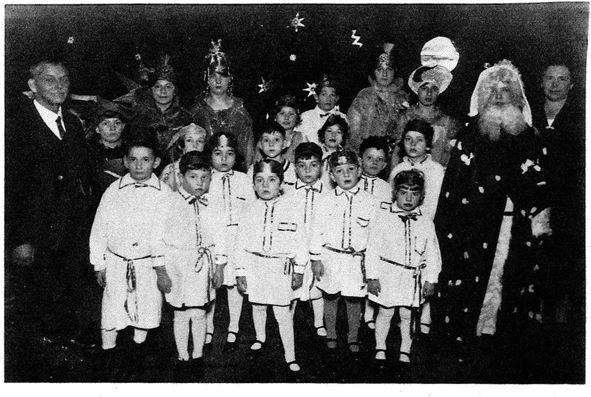
with teacher Haymann (far left)
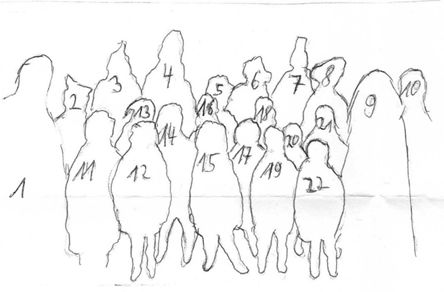
Nr. 2: Fred Samuel
Nr. 6: Hans Baer
Nr. 11: Hugo (Herbert Heinrich) Baer
Nr. 12: Rudi Metzger
Nr. 22: Henny (Henriette) Metzger
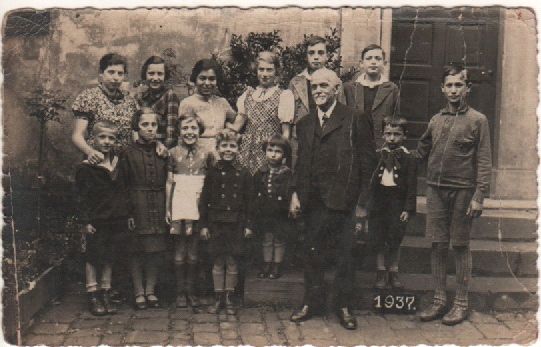
On February 16 2008 Gunter Demnig laid Stolpersteine in front of the house at former Hauptstr. 45 in memory of the murdered members of the Baer and Metzger families.
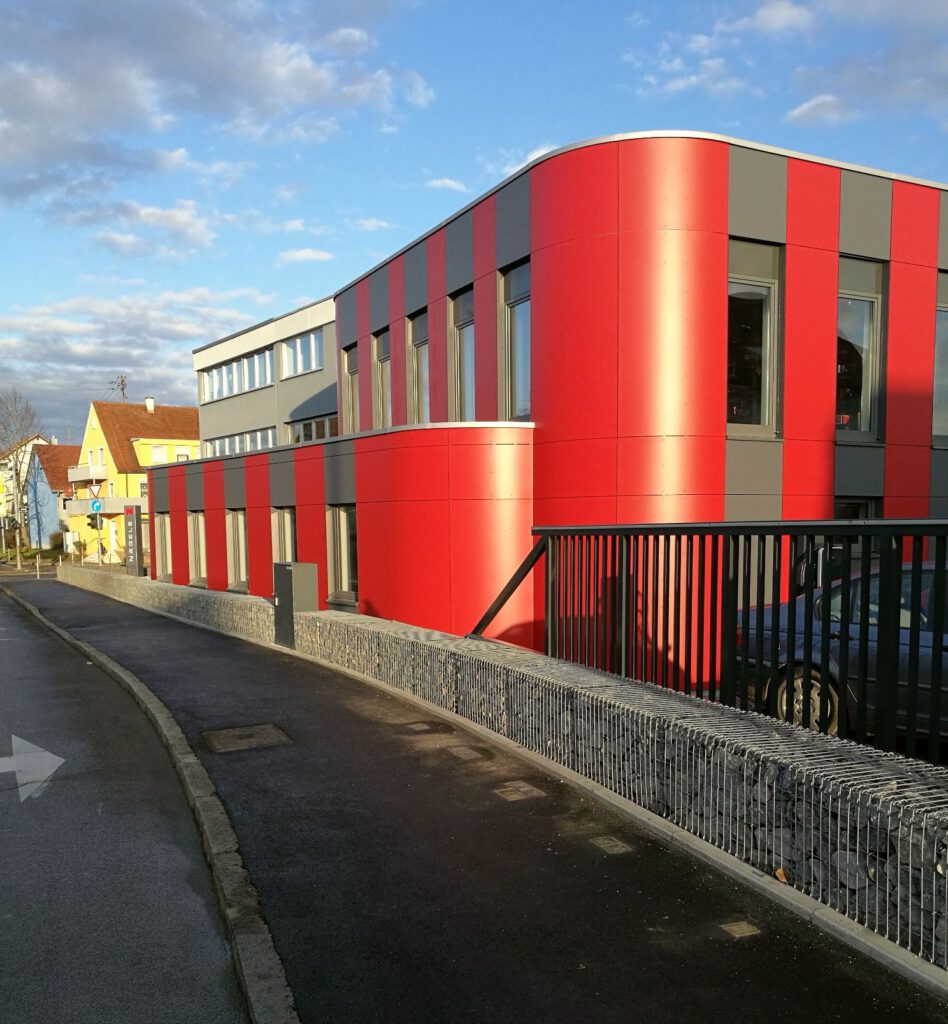
Text and Research by Peter Conrad (born in Rodalben)
(28.04.2020 pc/pr)
















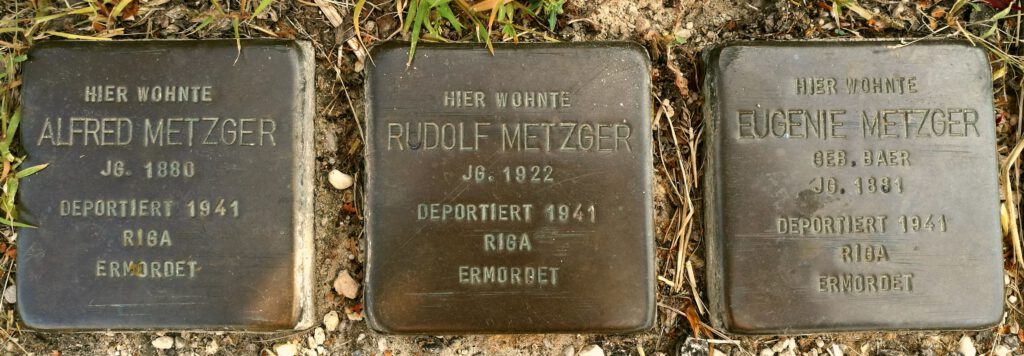


Leave a Reply